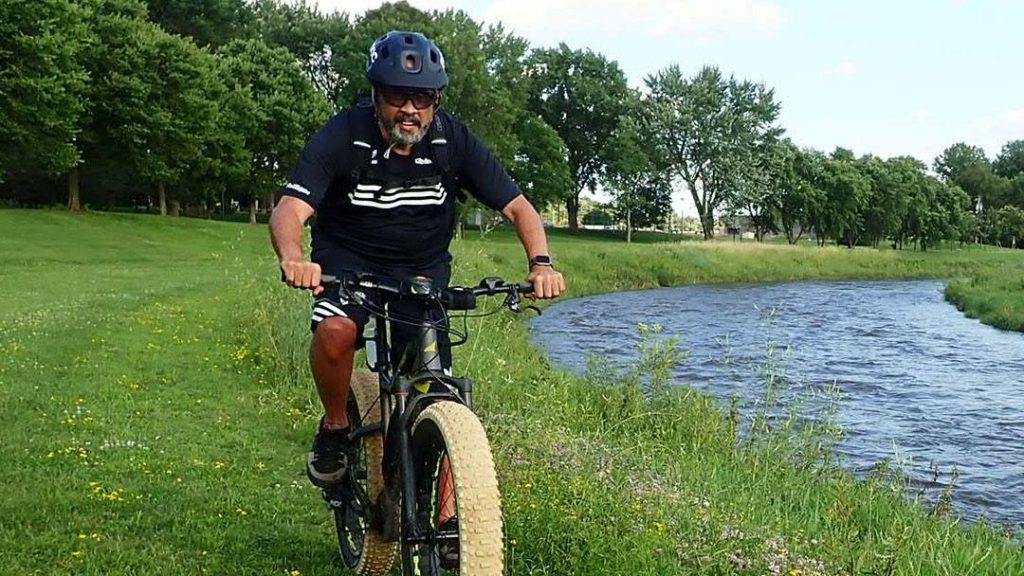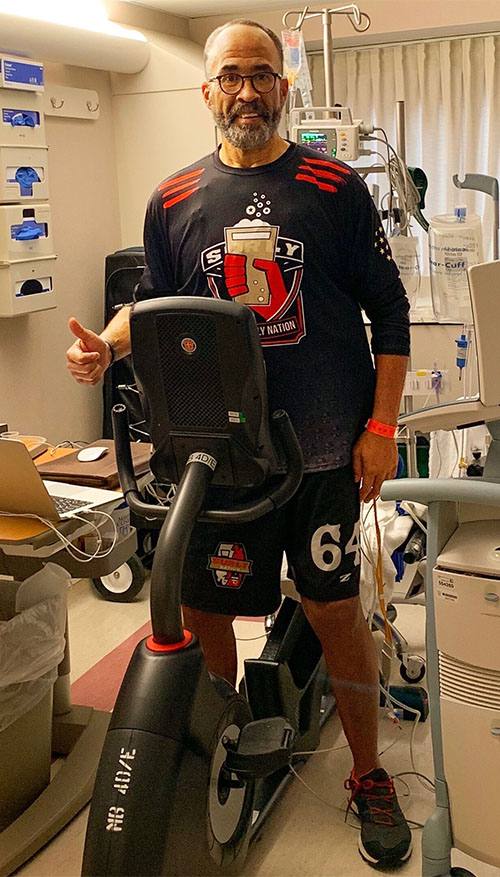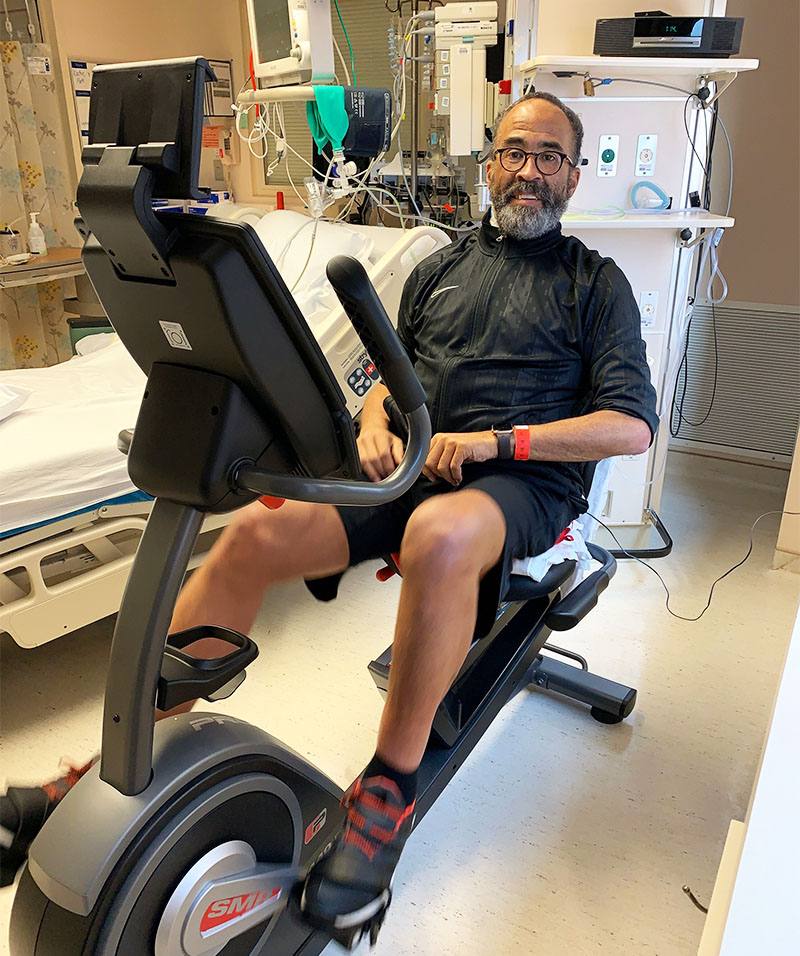-
Sharing Mayo Clinic: Pedaling his way to a heart transplant

Told he needed a heart transplant to stay alive, Greg Williams could have simply sat back and waited. Instead, he chose to take ownership of his health by exercising in his hospital room at Mayo Clinic right up until the day of his transplant in hopes of preparing his body and mind as best he could for what was to come.
Greg Williams was faced with a choice. Cardiologists at Mayo Clinic in Rochester had told Greg the rare disease amyloidosis that had brought him into their care was progressing, and it would likely lead to life-threatening congestive heart failure within four years if he didn't get a heart transplant. Greg could either go home to Lauderdale, Minnesota, and leave what might have been the last years of his life to chance, or he could actively try to do something about it.
Greg chose the latter.
"I didn't know whether I'd truly just have the four years left or whether a heart transplant would become an option," Greg says. "Either way, I wanted to make the most out of the time I had. I researched everything I could on congestive heart failure, heart transplantation and amyloidosis. My mantra of sorts became: Chance favors the prepared mind, body and spirit."
In addition to his research, Greg changed his diet and started exercising in hopes of reversing his medical misfortune as much as he could. "I'd always been pretty active," he says. "I played Ultimate Frisbee for years. But after my diagnosis, I also started lifting weights, swimming and riding 14 miles on my Fat Tire bike three or four times a week."
It was all in an effort to take more ownership of his health. "One thought that I had in my head through all of this was that I wanted to be a good team member for my care team at Mayo Clinic for whatever medical scenario it was that I was going to ultimately be involved in with them," Greg says. "I wanted to be able to be directed and coached, while also being as knowledgeable as possible about what was coming because the more you know, the less anxiety and trepidation you have."
Building sweat equity
Greg maintained that mindset, along with a stringent exercise and diet routine, for the next 2½ years while routinely checking in with his cardiologist, Alfredo Clavell, M.D., medical director of Mayo Clinic's heart transplant service in Rochester. "At one point, I was talking with Dr. Clavell and some other cardiologists, and they said they thought I'd now be a good candidate for a heart transplant," Greg says. "They said while a transplant wouldn't cure my amyloidosis, it would definitely extend my life."
Greg celebrated this turn of events with more exercise and more visits to Mayo Clinic. "I started having more and more consultations with Dr. Clavell, and I also kept up with my training regimen to prepare myself for whatever was coming down the road," he says.
"Fortunately, my team of doctors was supportive of me continuing to work out and prepare myself as much as possible for the transplant."
Greg Williams
Despite his mental and physical preparation, however, Greg's health continued to decline. "I started down the road toward congestive heart failure again," he says. "But I still continued exercising and riding my bike as much as I could."
And he kept it up until Dr. Clavell called in March to let Greg know he'd officially been added to the national transplant waiting list. "I was then hospitalized in April as part of Mayo's Heart Transplant Program," he says. "Fortunately, my team of doctors was supportive of me continuing to work out and prepare myself as much as possible for the transplant."
So supportive was Greg's care team at Mayo Clinic Hospital — Rochester, Saint Marys Campus, that they not only encouraged him to continue exercising while he waited for a new heart, they helped him do it.

"After being admitted to Saint Marys, I ordered a recumbent bike for my hospital room from a department store in Rochester. But due to some technicalities, the bike couldn't be delivered to my hospital room. It had to be delivered to the front door of the hospital," Greg says. "My nurses took a cart down to the front of the building and lifted the bike onto the cart and then brought it up to my room. That's how it started."
Riding toward transplant
Before Greg could begin using his new bike, however, his care team had to make sure his failing heart was stable enough to handle the physical exertion.
"There are levels of escalating care that we have available, so that we can keep transplant patients sustained and going while they wait for a donor heart to become available," says Richard Daly, M.D., surgical director of Mayo Clinic's heart and lung transplant service in Rochester. "Initially, it's pills, and then it generally switches to an intravenous medication, and then the next level is some kind of mechanical support. And there are a lot of different ways of mechanically supporting the heart, all of which involve a pump of some kind."
After Greg's body failed to respond positively to the first two levels of treatment, the choice of what to do next was clear. "A balloon pump is straightforward because it can be placed without an open surgery," Dr. Daly says. "It can be done with just a needle stick and then positioned in the aorta to augment the work of the heart. For some patients, it makes a really dramatic difference."
Greg needed the balloon pump because he had developed a condition known as cardiogenic shock, in which the heart can't pump enough blood to meet the body's needs. "We'd exhausted all other treatment options before moving onto mechanical support for Greg," Dr. Daly says. "Greg responded very well to the balloon pump. But even with the pump, he was still pretty sick."
With the balloon pump in place, Greg started riding as far as his body and his bike would take him. "I was hospitalized for the entire month of May, and during that month I rode 60 miles every day," Greg says. "When I was diagnosed with amyloidosis, I weighed 305 pounds. When I was first hospitalized at Mayo Clinic in early May, I was down to 250 pounds. By the end of the month, I was down to 207."
New heart, same routine

Greg's daily rides inside his hospital room were about more than just weight loss, though. "It was also about me not leaving responsibility totally in the hands of my care team," he says. "It was about being a willing and active participant in my care."
That active participation continued to the day Greg received life-changing news. "On May 21, 2019, my cardiac transplant team came in and said, 'We think we have a heart for you, and we'd like to get ready to go into surgery this afternoon,'" Greg says. "I was of course filled with both nerves and excitement. So immediately after they left, the first thing I did was to jump back on the bike and ride another 35 miles right up until my cardiac nurse came back into my room and told me it was time to get scrubbed up for surgery."
When Greg woke up in Mayo Clinic's cardiac ICU a couple days later following the transplant, the first thing he wanted to know was whether his recumbent bike could join him and his new heart. "I felt fantastic, and I healed at an accelerated rate due to my training regimen and the exercise I'd done in the hospital," he says. "I wanted that to continue."
Dr. Daly agreed, with one stipulation. "He said I could have the recumbent bike in my cardiac ICU room with the understanding that I wasn't going to be riding the same 60 miles a day right away," Greg says. "He said I could tone it down to 20 miles a day, so I did that. I hopped on the bike and started riding my 20 miles a day three days after my transplant. I felt great and was just really in a good frame of mind post-transplant."
He felt so good that upon his discharge from the hospital, Greg decided to give other transplant patients the same opportunity for exercise he had while hospitalized. "I donated my recumbent bike to Mayo Clinic, and specifically to the Gift of Life Transplant House in Rochester," Greg says. "It's now there for other patients to use at any time."
"I'm going to use (my new heart) to the best of my ability and live my new life for as long as I can."
Greg Williams
Greg hopes that it will do for others what it did for him. "Since getting my new heart, I've been able to continue biking, swimming and lifting weights in Mayo's Cardiac Rehab Program," Greg says. "I'm just so humbled, grateful and thankful that there was a donor out there who gave me this opportunity. That's really motivating me to make sure I'm taking care of myself and my new heart, and that it's not being wasted. I'm going to use it to the best of my ability and live my new life for as long as I can."
Greg can do that, Dr. Daly says, thanks to the groundwork for success Greg laid before the transplant. "I don't know many people who would be as sick as him and still work so hard every day to do some kind of exercise," Dr. Daly says. "For anyone of us to exercise daily takes such discipline and effort. To do it when you feel terrible and get short of breath by just walking across the room shows incredible effort on his part. Greg was an amazing patient."
HELPFUL LINKS
- Read more about the symptoms and causes of amyloidosis.
- Learn about heart transplants at Mayo Clinic.
- Visit the Mayo Clinic Transplant Center.
- Connect with others talking about transplants on Mayo Clinic Connect.
- Explore Mayo Clinic.
- Request an appointment.







